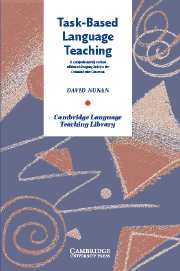Book contents
- Frontmatter
- Contents
- Acknowledgements
- Introduction
- Chapter 1 What is task-based language teaching?
- Chapter 2 A framework for task-based language teaching
- Chapter 3 Task components
- Chapter 4 An empirical basis for task-based language teaching
- Chapter 5 Focus on form in task-based language teaching
- Chapter 6 Grading, sequencing and integrating tasks
- Chapter 7 Assessing task-based language teaching
- Chapter 8 Tasks and teacher development
- Appendix A Approaches and methods – an overview
- Appendix B A unit of work based on the six-step procedure presented in Chapter 2
- Appendix C A unit of work based on the task/exercise typology in Chapter 5
- Appendix D Graded activities for the four macroskills
- Appendix E Common reference levels: self-assessment grid
- Glossary
- Index
Chapter 7 - Assessing task-based language teaching
Published online by Cambridge University Press: 16 February 2010
- Frontmatter
- Contents
- Acknowledgements
- Introduction
- Chapter 1 What is task-based language teaching?
- Chapter 2 A framework for task-based language teaching
- Chapter 3 Task components
- Chapter 4 An empirical basis for task-based language teaching
- Chapter 5 Focus on form in task-based language teaching
- Chapter 6 Grading, sequencing and integrating tasks
- Chapter 7 Assessing task-based language teaching
- Chapter 8 Tasks and teacher development
- Appendix A Approaches and methods – an overview
- Appendix B A unit of work based on the six-step procedure presented in Chapter 2
- Appendix C A unit of work based on the task/exercise typology in Chapter 5
- Appendix D Graded activities for the four macroskills
- Appendix E Common reference levels: self-assessment grid
- Glossary
- Index
Summary
Introduction and overview
Task-based language teaching presents challenges in all areas of the curriculum. This is particularly so in the area of assessment. Traditional, language-based curricula provide a convenient basis for the assessment specialist whose point of departure in developing assessment instruments is to provide a representative sampling of the grammar, vocabulary and phonological features of the language. These are then assessed, usually through some indirect form of assessment. While it is always possible to continue using traditional methods to assess students who are learning through task-based teaching, this violates a key curriculum principle, which is that assessment should reflect what has been taught.
Aligning this principle with TBLT makes direct assessment inevitable. An additional problem, as we saw in Chapter 5, is that there is rarely a simple one-to-one correlation between communicative tasks and the linguistic elements through which they are realized (Willis and Willis, 2001).
Understandably, this chapter draws on some of the research summarized in Chapter 4. It also reports on some additional research related specifically to assessment.
Key concepts in assessment
Evaluation versus assessment
In this chapter, I will draw a distinction between evaluation and assessment, two terms which in some contexts are used interchangeably. For me, ‘evaluation’ is a broad, general set of procedures involving the collection and interpretation of information for curricular decision-making. This information will generally include data on what learners can and cannot do in the language. Procedures for collecting this learner data are referred to as ‘assessment’. Assessment is thus a subset of evaluation. Testing is one form of assessment.
- Type
- Chapter
- Information
- Task-Based Language Teaching , pp. 138 - 165Publisher: Cambridge University PressPrint publication year: 2004



